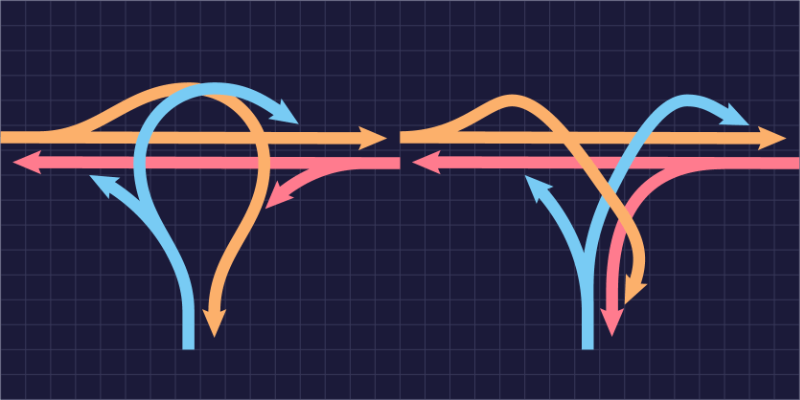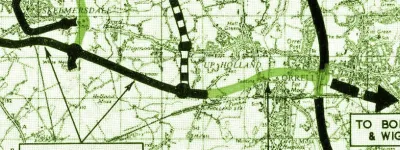This is not so much one design of junction as a whole range of related options that, individually, have all sorts of names. Their common feature is that they provide a free-flowing junction to terminate one motorway on another without using any loops.
Limited-access roads
Surface roads
Vertical levels
Bridges required
Access between roads
Number in UK
First built in UK
The difference between the many types of Triangle is how many times the sliproads cross over each other, and whether the junction is designed to be spaced out, rising only two levels high, or more compact with sliproads stacked up three high. The illustration above shows a three-level example, but with some rearrangement it could be built on two levels over a larger area.
Regardless of how exactly you choose to build it, the resulting junction is free-flowing and reasonably fast, with no trumpet-style loops to slow traffic down.
For a long time Roads.org.uk referred to all these interchanges by the name "directional T", and that's what this page used to be called, but that name is really a specific term for a variant of the junction that doesn't exist in the UK. "Triangle" is the British term for one of the most common types, and all of them form a triangle between three roads, so perhaps it's the most appropriate. A full triangle, like at M5/M6 Ray Hall Triangle or the junctions at either end of the M18, is made up of three fork junctions with a triangle of linking roads between them.
The earliest junction of this type in the UK is the M6/M55 interchange north of Preston, opened in 1965. It has three levels of roadway.

Why build one?
The simplest reason is that one motorway needs to terminate on another and the junction must provide access in all directions and handle large volumes of traffic. Where a roundabout interchange would not provide a free-flowing connection, and a trumpet has limitations on its capacity due to the looped sliproad, a triangle will keep everything moving at top speed.
One significant advantage is that this type of junction can be configured to give priority to specific flows of traffic. With a trumpet, when you approach the junction on the terminating road you must take the left sliproad to turn left and the right sliproad to turn right. What if the vast majority of your traffic is going left? In that situation it would make more sense to have the main carriageway of your road turn left, and have right-turners leave on a sliproad: a triangle junction will let you do that.
Equally you can mix and match the priority of your roads, choosing an arrangement of sliproads that best suits the traffic flows.
One of the more overlooked benefits of this junction type is that it requires very little space opposite the terminating road. A trumpet interchange needs space for a big loop, but a triangle has very little impact on whatever is at the other side of the major route. That makes it suitable in urban areas or where the through road runs up against an obstacle like a parallel railway line or a river.
Advantages
- Handles high volumes of traffic with ease.
- Easy for the motorist to use.
- Design can be adjusted to suit almost any situation.
Disadvantages
- Usually more expensive than a comparable three-way junction like the trumpet.
- May involve difficult or complex bridge structures.
- Difficult to expand or increase capacity.
Variations
This is an interchange that is all about the variations.

This is the layout that is really described by the name triangle. Very often the three corners are spaced out (sometimes by distances measured in miles) making a fast, smoothly flowing junction that is very low-lying.

The term "directional" refers to a sliproad that leaves on the left side of the road to turn left and on the right side to turn right. By arranging the sliproads from the terminating motorway in this way, traffic approaching the end of the road has an intuitive choice, and we've created a semi-directional T.

By arranging all the sliproads directionally - so that on all approaches you keep left to turn left and keep right to turn right - we create a fully directional T. In the USA this is considered the original and standard form of this type of junction, but none exist in the UK. One was planned in Glasgow, and there are stub sliproads for it between junctions 15 and 16 of the M8, but it was never completed. Two of the three corners of the M27/M275 interchange are arranged like this too.
With thanks to David, Dave Robinson and Peter Edwardson for information on this page.

